ABSTRACT
In temperate climatic regions where severe winter conditions persist, the winter hardiness and fruit yield of strawberry cultivars vary greatly in perennial production systems. A 4-year study was carried out to investigate the wintering ability of different June-bearing strawberry cultivars in the cold semi-arid continental climate of Manitoba between 2015 and 2018. The wintering index and yield traits of early, mid, and late season strawberry cultivars were evaluated. Six different cultivars tested in each year. ‘Wendy,’ ‘Kent’, and ‘Cabot’ were common in each year. Mid-season cultivar ‘Kent’ and ‘Mira’ yielded significantly (p< .05) higher with greater wintering index compared to early and late season cultivars within each trial and across 4 years. Low winter temperatures with less snow on grounds establish pronounced effect on early season cultivars wintering index. A significant variation for temperatures was recorded for the months within and between years.
Introduction
A wide range of fruit crops are grown commercially in the Canadian cropping system despite its high altitudes with shorter growing season. Fruit production accounts for 16.8% of total cash receipts for edible horticulture in Canada (Statistic Canada, Citation2018a). Amongst the fruits crops, berry fruits including blueberries (Vaccinium corymbosum) (59%), cranberries (Vaccinium macrocarpon) (6%), and strawberries (Fragaria × ananassa) (3%) cultivated area contribute major share in fruit crop production with farm-gate value of 20%, 11%, and 12%, respectively. Within the Canadian agricultural cropping areas, southern Ontario and southwest British Columbia regions that receive ~180 frost-free days produce more fruit crops compared to other regions.
In Canada, strawberries are the fourth most important fruit crop in terms of value ($128.2 million, 12.3%), and ranked fifth fruit crop in terms of marketed production (28,372 t, 3.4%) (Statistics Canada, Citation2018b). Increases in production area, price, and farm-gate value of strawberry have been the trend within the past five consecutive years. This trend seems mainly due to increase in yields, adaptability, and adoption of new varieties. Moreover, increased fruit consumption also resulted in increased fruit imports in Canada, with strawberries occupying the position among the top three crops imported in 2017 accounting for 436.8 million dollars and 8.6% of dollar value (Statistics Canada, Citation2018b).
Within various Canadian cropping regions, Manitoba borders the northern margin for agricultural production, limiting cropping season from 125 to 135 frost-free days for commercial fruit production (Manitoba Ministry of Agriculture, Citation2018). In this cropping region, strawberries, with 110 ha, ranked first amongst fruit crops (Statistics Canada, Citation2018b). Commercially, June-bearing cultivars of strawberries belonging to early, mid, and late season maturity groups are grown in a matted row system. Fluctuating seasonal temperature changes, frequent frost at bloom in spring and short growing season with long day conditions limits strawberry growing conditions for growers in this region. Winter freezing damage is very common as temperatures drop below −20°C for several weeks during winter months and this temperature may, sometimes, be devastating to the plants (Dale et al., Citation2000). Growers use straw mulch as an option to protect strawberry plants from the cold and the fluctuation temperatures, desiccation, and frost heaving. Strawberry plant winter hardiness was examined by various researchers under both field and protected environment conditions. Different studies involving varied methods of crop production (Linde et al., Citation2015; Turner et al., Citation1993), plant development stages (Rugienius and Stanys, Citation2002), different growth media (Palonen and Buszard, Citation1997), and using planting material propagated through different methods (Palonen and Lindén, Citation2001) reported non-consistent winter hardiness in using different methodologies. Palonen and Buszard (Citation1997) reported that cold hardiness tested in vitro did not correspond to cultivars relative hardiness when tested in field conditions, and argued that cold hardiness best revealed after cultivar acclimation in particular colder climate. Expanding on cultivar acclimation, Rugienius et al. (Citation2016) revealed that strawberry genotypes were found to be most winter hardy after 56 days of acclimation in a cold tolerance of microshoots study of different genotyped of genera Fragaria in 7, 14, 21, and 56 days of acclimation, by measuring ions leakage and evaluating critical temperature after freezing in vitro condition. However, it has also been reported that strawberry plant has an ability to recover from the winter injury in most cases but it could not be recoverable when low temperature persists for a longer period with limited snow cover (Daugaard, Citation1998; Nestby et al., Citation2000) which may result up to 20% in yield losses. Performance of day-neutral strawberries was examined by Taghavi et al. (Citation2016) under field and high tunnels growing conditions at different environments in Ontario cropping region. The results revealed that the higher yields for summer crop were achieved under high tunnels as compared to field conditions in cooler environments. This research calls for developing advanced and improved high tunnel production practices that provide plant protection from winter injury and season extension for day-neutral cultivars for crop production in colder climates. However, Hietaranta and Karhu (Citation2014) suggested improved climatic adaptive, field-grown strawberries, cultivars for colder climates.
The objectives of this study were: (1) to examine and compare the wintering ability, yields and fruit qualities of early, mid, and late season June-bearing strawberries for production in Canadian prairies, in particular Manitoba, growing environment; and (2) to develop an understanding for studying cold hardiness during winter months and to assess the responses of introducing new strawberry cultivars.
Materials and Methods
Experimental Site and Plant Material
Two sets of experiments were conducted in a 4-yr study at Assiniboine Community College (ACC), Brandon, Manitoba, Canada (Latitude: 49°50′48″ N, Longitude: 99°57′11″ W). The experimental site was located southeast and southwest sides of the ACC Research Grow Plot. Each set of experiment continued for three successive growing seasons. Strawberry cultivars tested in Experiment 1 (2014–2016) were ‘Glooscape’ and ‘Wendy’ (early season cultivar that start producing berry in late spring), ‘Kent’ (mid-season cultivar that fruits about a week after early season), ‘Cabot’ (mid to mid late season-fruiting, about 10 days after early season cultivars), ‘Jewel’ and ‘Valley Sunset’ (late season, produce berry about 12–14 days after early season cultivars). Whereas ‘Annapolis’ and ‘Wendy’ (early season), ‘Kent’ and ‘Mira’ (mid-season), ‘Cabot’ (mid-late season), and ‘St. Laurent’ (late season) were tested in Experiment 2 (2016–2018). Planting was done on May 20, 2014 for Experiment 1; and May 15, 2016 for Experiment 2.
Planting and Fertilizer Application
In both experiments, ten (10) plants per plot were hand-planted in a single row. Plants were staggered with 0.45 m between plants and 1.5 m between rows. In-ground microdrip tape-row crop dripper line –0.95 L h−1 (Irritec USA Inc.) was used for irrigation and fertigation in both experiments. Plants were irrigated 3 h per day twice a week in spring and fall whereas in summer months, plants were irrigated thrice in a week using irrigation timer and adjusting for previous week rainfall received. Two hundred ppm of nitrogen from a commercial soluble fertilizer blend of 18-9-18, a total of 725 g of Nitrogen/93 m2/season, applied in four applications (181 g per application) with injector ratio 1:100 using Dosatron (D125-Dosatron International, Inc., USA). Total amount of fertilizer were split into four different applications during each cropping season. Cultural practices, including hand hoeing, weeds, and pest control, were adapted to local soil and climatic conditions (Alberta Agriculture, Citation2015). Experimental plots were covered with ~5- to 6-inch thick wheat straw mulch when air and soil temperature dropped below −7°C and 5°C, respectively, to protect plants from winter injury.
Fruit Yield and Quality Analyses
All flowers that emerged in Experiments 1 and 2 were removed in planting year to encourage vegetative plant growth and daughter plants development. Fruit harvesting for both trials was done at weekly interval during the months of June and July. Berries were harvested manually and yield from each plot was calculated into grams per plant by using number of plants in each plot. At harvest, fruits were sorted into marketable (disease free and regularly shaped with berry diameter greater than 25 mm) and unmarketable fruits (rotten and misshapen with berry diameter less than 25 mm). Total yields were calculated as the sum of marketable and unmarketable yields. Fruit weight (from five marketable fruit/plot) was determined from each harvest and averaged over season. The firmness of 20 berries of each cultivar (i.e., five from each of the four replications) was measured using GUSS Fruit Texture Analyzer (GS-25). Soluble solid contents were measured using an Atago PAL 3 digital refractometer (ranging 0–93%).
Wintering Ability
Plant counts were done in the fall of planting/previous year and again the following spring, after straw removal, when plants started leafing out to determine plant establishment and winter ability for each experiment planted in 2014 and 2016. All mother plants and daughter plants were evaluated for winter survival. Plant wintering ability was assessed by counting the dead, severely injured (more than half of the crown lost), slightly injured (less than half of the crowns lost), and uninjured plants. These four categories were given coefficients between 0 and 1 at even intervals, i.e., 0, 0.33, 0.67, and 1. A wintering index was calculated from the data as: (n1/n 1.00) + (n2/n 0.67) + (n3/n 0.33) + (n4/n 0.00); where n1, number of uninjured plants; n2, number of slightly injured plants; n3, number of severely injured plants; n4, number of dead plants; and n, total number of plants (Hietaranta and Parikka, Citation2008).
Climate Data Acquisition and Monitoring
Climatic conditions were recorded using Argus Titan system version 718 (Argus Control Systems Ltd., Canada) and from Brandon Meteorological Station ID: CA005010490 (Environment Canada, Citation2018). Titan WS2 weather station was configured with the Argus Titan Control System to record on-site weather information for outdoor temperature (°C), light energy (W/m2), wind speed, and wind direction.
Experimental Design and Analysis
The experiments were laid out in a randomized complete block design with four replications. There were 10 plants of each cultivar per plot. Data were subjected to analyses of variance (ANOVA) using CoStat ver. 6.45 (CoHort Software, USA). Differences between treatment means were determined using Fisher’s least significant difference at α = 5%.
Results
Minimum, maximum, and average monthly air temperatures for Experiment 1 (2014–2016) varied between years 2014–2015 and 2015–2016 for the winter months. Minimum temperature with high snow on ground was recorded in 2014–2015 in February whereas in 2015–2016, January was recorded as the coldest month and February with high snow on ground (). Low temperatures in November (2014 and 2017), December (2016 and 2017), January (2015 and 2017), February (2015), March (2017), and April (2018) were recorded as an extreme event during each winter month (). The measured characteristic for the strawberry trial evaluated in Experiment 1 was highly significant for cultivars which is the main source of variation, whereas year and its interaction with the cultivars were found to be non-significant (). Strawberry cultivar ‘Kent’ had the highest average total and marketable yields over the 2-year average () and within each year (data not presented). Significantly higher (p = .05) brix percentage for ‘Glooscape,’ ‘Kent’, and ‘Valley Sunset’ over ‘Wendy’ ‘Cabot’ and ‘Jewel.’ A significantly higher wintering index was found for ‘Wendy’ comparing with ‘Glooscape,’ ‘Kent,’ ‘Cabot,’ and ‘Valley Sunset,’ whereas non-significant wintering index with cultivar ‘Jewel’ (). Over two year’s average, cultivar ‘Wendy’ had the highest wintering index and berry firmness. Cultivar ‘Valley Sunset’ had lowest yields, comparable wintering index, berry firmness, and brix percentage similar to cultivar ‘Kent’ ( and ). Yields, plant, and berry characteristics from the cultivars evaluated during 2014–2016 revealed that mid-season cultivars ‘Kent’ had better yields and comparable plants and berry traits with other cultivars in this experiment. ‘Cabot’ has the largest berry followed by ‘Valley Sunset’ ().
Table 1. Monthly air temperatures (°C) and snow on ground (cm) during 2014–2015, Citation2015–2016, 2016–2017, 2017–2018 from November to April.
Table 2. F ratios of yields, growth, and berry characteristics of six different June-bearing strawberry cultivars evaluated during 2015–2016 and 2017–2018.
Table 3. Wintering index, berry firmness, total soluble solids, and berry weight for strawberry cultivars grown during 2014–2016.
Figure 1. (a–f): Daily minimum air temperature variations during year 2014–2018 from November to April.
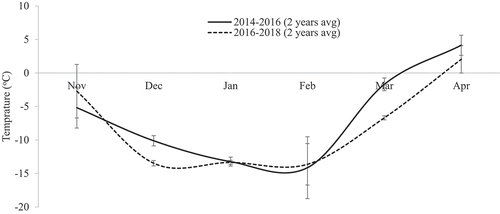
Figure 2. Total and Marketable yield (g.plant−1) of strawberry cultivars evaluated during 2015–2016. Different letters on mean bars indicate the significant difference (p < .05), according to the LSD test. Data presented are means of 2 years (2015–2016).
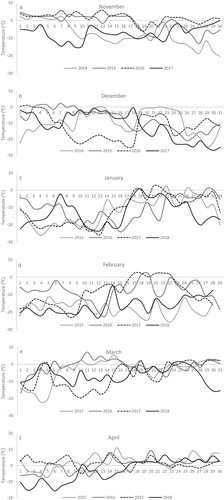
Experiment 2 had also varied minimum, maximum, and average air temperatures between years 2016–2017 and 2017–2018 winter months. Minimum temperature was recorded in December followed by January, with high snow on ground for the month of March during 2016–2017, whereas minimum temperature in February and high snow on grounds in March recorded for year 2017–2018 (). Minimum daily extreme temperatures for the years 2016, 2017, and 2018 were recorded in the month of December, January, and April, respectively (). The analysis of variance for Experiment 2 revealed that the main source of variation for ‘cultivars’ was highly significant. However, year × cultivar interaction was not significant for all traits assessed in this experiment except for marketable yield (). Cultivar ‘Mira’ had a highly significant (p = .05) wintering index than early season, cv. ‘Wendy’ and late season cv. ‘Saint Laurent’ ( and ). Mid-season cultivar ‘Kent’ had the highest yields followed by cultivar ‘Mira’ (). ‘Saint Laurent’ had the lowest yields and wintering index ( and ). Strawberry cultivars ‘Annapolis, and ‘Wendy’ had non-significant, total and marketable yield, and berry firmness. ‘Cabot’ had the largest berry with highest berry weight ().
Table 4. Wintering index, berry firmness, total soluble solids, and berry weight for strawberry cultivars grown during 2016–2018.
Figure 3. Wintering Index for the strawberry cultivars evaluated during the year 2017 and 2018. Vertical bars ±SE (n = 4). Wintering index was calculated from the data as: (n1/n 1.00) + (n2/n 0.67) + (n3/n 0.33) + (n4/n 0.00); where n1, number of uninjured plants; n2, number of slightly injured plants; n3, number of severely injured plants; n4, number of dead plants; and n, total number of plants.
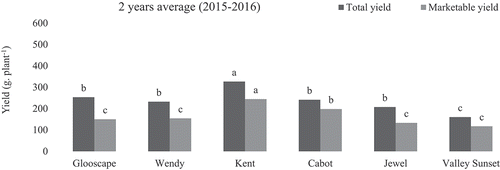
Figure 4. Total and Marketable yield (g.plant−1) of strawberry cultivars evaluated during 2017–2018. Different letters on mean bars indicate the significant difference (p < .05), according to the LSD test. Data presented are means of 2 years (2017–2018).
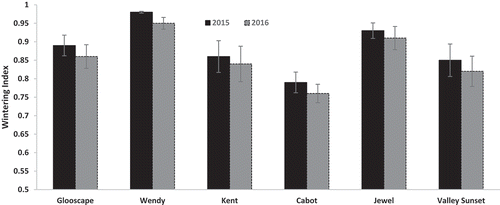
The different strawberry cultivars varied in plant growth, berry characteristics, and yield. Mid-season cultivars particularly, ‘Kent’ had the highest yield and plant and berry characteristics in both experiments 1 and 2. Whereas, late-season cultivar ’Valley Sunset’ from Experiment 1 (2014–2016) and cultivar ‘Saint Laurent’ from Experiment 2 (2016–2018) had the lowest yields ( and ).
Discussion
Severe winter conditions with fluctuation and combination of low temperatures, spring and fall frost occurrence, and the amount of snow cover are the major limiting factors for perennial strawberries field production in the Canadian prairies environment. Variations in extreme low air temperature and large amount of snow on the ground were recorded in the winter months (November to April) during the 4 years of the study (). However, year as a source of variation in these experiments was found to be non-significant (p = .05) () and this could be due to acclimation abilities of the cultivars during the freeze-thaw cycles when high and frequent fluctuations in temperature occur (Lukosevičiūtė et al., Citation2009). Similarly, the different cultivars did not show any significant differences in total yield, plant, and berry data recorded as an interaction with years. However, cultivar × year interaction was significant for marketable yield in 2017–2018 experiment, where marketable yields differ between production years (data not presented). In contrast, Taghavi et al. (Citation2016), who compared day-neutral strawberry cultivars for yield and berry quality within and between different geographical environments in Ontario found all main sources of variation and their interaction, highly significant for all measured characteristics. Overall, Taghavi et al. (Citation2016), found that the yield and fruit quality of the cultivars tested were consistent within and between the environments. Kikas and Libek (Citation2005) reported similar result of having low yield while investigating the effect of temperature sums on growth and yield of strawberry cultivars and reported low yield of cultivars tested including cultivar ‘Kent.’ While comparing the low temperature hardiness of strawberry plants under field and controlled conditions at Saskatoon, Saskatchewan, Canada, Turner et al. (Citation1993) observed differences in cold hardiness in mother and daughter plant under field and controlled conditions. This seems to be in agreement with this study, where mother plants in establishment year may have effected more as compare to daughter plants in the following year and had yield impact between years.
Overwintering ability of cultivars tested in the present study varied between cultivars ( and ), which is in agreement with Hietaranta and Parikka (Citation2008) results where they found that different cultivars performed better over other in overwintering with varying temperature and snow depth evaluated over a 3-year experiment. Similar trend of varied temperatures for the months between years ( and ) was observed in this study. Studies established by Masny and Żurawicz (Citation2014) observed pronounced differences in plant vigor when exposed at −10°C. In another study, Linde et al. (Citation2015), while evaluating winter hardiness of strawberry genotypes, revealed January as the most distinguished winter month and ability to survive lengthy exposure to low temperatures are the differentiating indicators for winter hardiness. This is apparent in this study where strawberry cultivars ‘Wendy,’ ‘Kent’, and ‘Cabot’ were common in both set of experiments and their performance can be compared over the 4 years of the study. ‘Wendy’ had better wintering index in 2014–2016 compared to 2016–2018 experiment, while ‘Cabot’ had better wintering index in 2016–2018 experiment compared to 2014–2016. Cultivar ‘Kent’ showed a consistent wintering index and high yield performance over 4 years ( and , and ) in varied and prolonged low temperature during 2014–2018. ‘Kent’ had a significant difference in yields and brix, and had comparable wintering index and berry firmness over ‘Wendy’ and ‘Cabot’ in 4 years combined data (Table presented). Therefore, ‘Kent’ a mid-season cultivar, proved to be the best-acclimatized June-bearing cultivar for Manitoba climatic conditions. However, the 2-year average, total and marketable yields for ‘Wendy,’ ‘Kent,’ and ‘Cabot’ are consistent in rankings in both experiments. In addition, data for this study present non-significant differences for berry firmness and soluble solids between ‘Wendy,’ ‘Kent,’ and ‘Cabot’ cultivars in Experiment 2 and significant differences in Experiment 1, which demonstrates that berry firmness and soluble solids traits did not correspond to the cultivars winter hardiness. Palmieri et al. (Citation2017) study the influence of temperature and other abiotic factors on the quality and the composition of fruits in nine strawberry cultivars grown at three different altitudes and found that the accumulation of a number of secondary metabolites in strawberry fruits grown in different environment conditions had acclimation effects in terms of plant response to abiotic stress.
Figure 5. Monthly, 2 years averaged, air temperature variations during year 2014–2016 and 2016–2018 from November to April. Vertical bars ±SE (n = 240, 248, 248, 224, 248, 240 for November, December, January, February, March, and April, respectivelyy).

Figure 6. Wintering Index for the strawberry cultivars evaluated during the year 2015 and 2016. Vertical bars ±SE (n = 4). Wintering index was calculated from the data as: (n1/n 1.00) + (n2/n 0.67) + (n3/n 0.33) + (n4/n 0.00); where n1, number of uninjured plants; n2, number of slightly injured plants; n3, number of severely injured plants; n4, number of dead plants; and n, total number of plants.
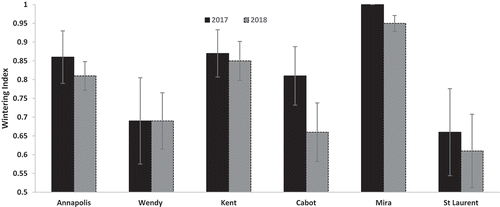
The results from this study indicate the influence of genetic diversity and environmental adaptation of the cultivars on yields, plant, and fruit quality traits, in both experiments. The results from this study also reveal that the wintering index of the mid-season cultivars ‘Kent’ (in 4 years) and ‘Mira’ (in 2 years) performed consistent and better in comparison to early season cultivars ‘Glooscape,’ ‘Wendy,’ ‘Annapolis,’ and late season cultivars ‘Jewel,’ ‘Valley Sunset,’ ‘Saint Laurent. The studies also put forward an understanding of how variation in low temperatures and snow cover during winter months of a particular year and between year’s impact wintering ability of strawberry cultivars in particular, early and late season cultivars, which were found inconsistent in yields and wintering ability in this study. However, findings in this study demonstrate and lay the foundation of cultivar variation in wintering ability under temperate field conditions, which might indicate the presence of adequate genetic diversity among the cultivars, which allow for the selection of new cultivars with better plant and berry traits that are more suitable to specific environmental conditions. Future research direction could be exploring cultivars at a molecular breeding level to ascertain any gene association with wintering ability for early, mid, and late season strawberry cultivars.
Acknowledgments
The authors acknowledge the financial support, for this project, provided by Agriculture and Agri-Food Canada and the Manitoba Ministry of Agriculture through the Canada-Manitoba Growing Forward 2, a federal provincial territorial initiative. We would like to thank Prairies Fruit Growers Association for providing in-kind support for this project.
Additional information
Funding
References
- Alberta Agriculture, 2015. Commercial strawberry production on the prairies, publication agdex 232/20-1. https://www.agric.gov.ab.ca/app08/ppsropintheweb?PubID=100035
- Dale, A., J. Walker, and P. Fisher. 2000. Growing strawberries in Ontario. Publ. 513. Ontario Ministry of Agriculture, Food and Rural Affairs, Toronto.
- Daugaard, H. 1998. Winter hardiness and plant vigor of 24 strawberry cultivars grown in Denmark. Fruit Varieties J. 52:154–157.
- Environment Canada, 2018. Environment and natural resources. climate data, Brandon Manitoba RCS station. http://:www.climate.weather.gc.ca/climate_data/daily_data_e.htm.
- Hietaranta, T.P., and S.T. Karhu. 2014. Enhancing strawberry production at high latitudes. Acta. Horti. 1049(1049):73–76. doi: 10.17660/ActaHortic.2014.1049.4.
- Hietaranta, T.P., and P. Parikka. 2008. Suvetar and valotar- new strawberry cultivars. J. Agr. Food Sci. 17(2):146–152. doi: 10.2137/145960608785328224.
- Kikas, A., and A. Libek. 2005. Influence of temperature sums on growth and fruit mass and yield of strawberry. Europ. J. Hort. Sci. 70 (2):85–88. 1611–4426.
- Linde, O.L., P. Palonen, and T. Hytonene. 2015. Evaluation of three methods to assess winter hardiness of strawberry genotypes. J. Hortic. Sci. Biotech. 77(5):580–588. doi: 10.1080/14620316.200211511542.
- Lukosevičiūtė, V., R. Rugienius, I. Zalunskaite, A. Sasnauskas, and V. Stanys. 2009. Strawberry cold hardening investigations in vitro. Acta. Hortic. 842:78992. doi: 10.17660/actahortic.2009.842.173.
- Manitoba Ministry of Agriculture 2018. Agricultural climate of Manitoba. https://www.gov.mb.ca/agriculture/weather/climate-of-mb.html.
- Masny, A., and E. Żurawicz. 2014. Controlled freezing as the cold temperature tolerance test of strawberry cultivars. Acta. Hortic. 1049(1049):893–896. doi: 10.17660/ActaHortic.2014.1049.144.
- Nestby, R., R. Bjørgum, A. Nes, T. Wikdahl, and B. Hageberg. 2000. Winter cover-affecting freezing injury in strawberries in a coastal and continental climate. J. Hort. Sci. Biotech. 75(1):119–125. doi: 10.1080/14620316.2000.11511210.
- Palmieri, L., D. Masuero, P. Martinatti, G. Baratto, S. Martens, and U. Vrhovsek. 2017. Genotype‐by‐environment effect on bioactive compounds in strawberry (Fragaria x ananassa Duch.). J. Sci. Food Agri. 96(12):4180–4189. doi: 10.1002/jsfa.8290.
- Palonen, P., and D. Buszard. 1997. Screening strawberry cultivars for cold hardiness in vitro. Acta. Hortic. 439(439):217–220. doi: 10.17660/ActaHortic.1997.439.31.
- Palonen, P., and L. Lindén. 2001. Winter hardiness of micropropagated and conventionally propagated strawberry plants. J. Hortic. Sci. Biotech. 76(6):685–690. doi: 10.1080/14620316.2001.115111432.
- Rugienius, R., L. Šnipaitienė, G. Stanienė, J.B. Šikšnianienė, P. Haimi, D. Baniulis, B. Frercks, V. Pranckietis, V. Lukoševičiūtė, and V. Stanys. 2016. Cold acclimation efficiency of different prunus and fragaria species and cultivars in vitro. Zemdirbyste-Agriculture 103(2):207–214. doi: 10.13080/z-a.2016.103.027.
- Rugienius, R., and V. Stanys. 2002. Formation of cold hardiness in strawberry during early plant development stage. Acta. Hortic. 567(567):333–336. doi: 10.17660/ActaHortic.2002.567.71.
- Statistic Canada. 2018a. Fruit and vegetable production. CANSIM tables 001-0009 and 001-0013. https://www150.statcan.gc.ca/n1/en/daily-quotidien/180212/dq180212a-eng.pdf?st=BaYshAyt
- Statistics Canada, 2018b. Statistical overview of Canadian fruit industry 2017. 1925–3796. www.agr.gc.ca/horticulture_e.
- Taghavi, T., A. Dale, B. Hughes, J. Zandstra, and M.T. Charles. 2016. The performance of day neutral strawberries differs between environments in Ontario. Can. J. Plant Sci. 96:662–669. doi: 10.1139/cjps-2015-0276.
- Turner, J.M., K.K. Tanino, and C. Stushnoff. 1993. 1993: Evaluation of low temperature hardiness of strawberry plants under field and controlled conditions. Can. J. Plant Sci. 73(4):1123–1125. doi: 10.4141/cjps93-151.
